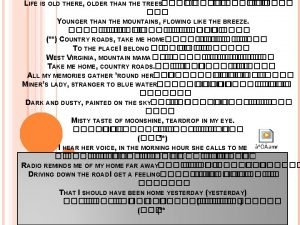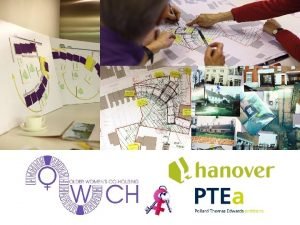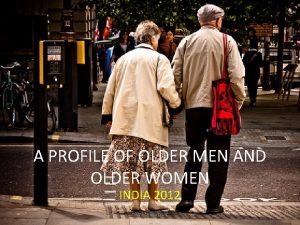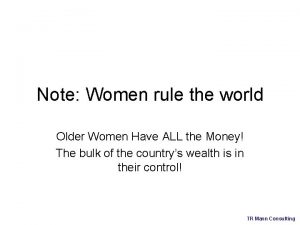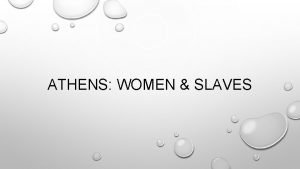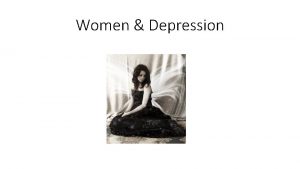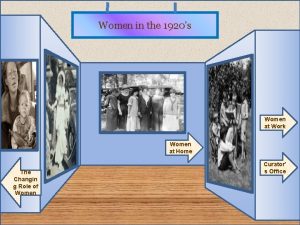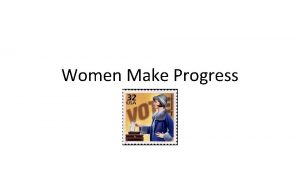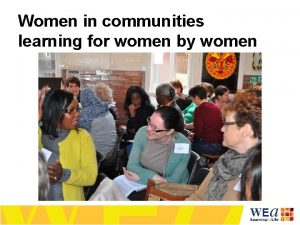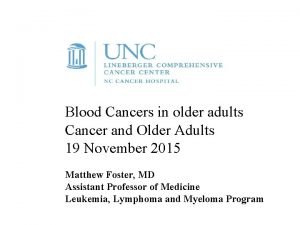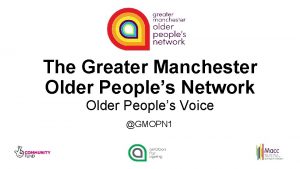OLDER WOMEN IN THE MEDIA Older Women in












- Slides: 12

“OLDER WOMEN IN THE MEDIA” Older Women in the Media: Their Access to Modern Communication and Information by Katalin Hajós, Board Member of AWCDH Board Member of IAA Hungarian Chapter RURAL OLDER WOMEN/WIDOWS: BEYOND POVERTY AND VIOLENCE: PROGRAMS/POLICIES CSW 62 PARALLEL EVENT Date and Time: March 14 from 12: 30 PM to 2: 00 PM Venue: 4 W 43 rd Street, Room: Green Room 1

Slowly Changing Stereotypes Let us be optimistic. The popular media is becoming increasingly age-friendly. But today's films and television shows are still filled with ageist stereotypes. Still, more and more older models are seen on the catwalks and there is high-end fashion designed for women 60+. 2

Facing the facts: different use and access to media Statistics Media Women comprise a significant majority of the older population. Women outlive men by 4. 5* years, and outnumber men by two to one at age 80 and over. Marketers’ target groups are slowly shifting from 18 -49 to 18 - 59. The 65 + population use media differently, they watch more TV than young people. The Internet became the major media channel. Older populations have a different pattern of using media: 40 % of the 65+ population use social media in the US 45 % of the elderly use the Internet at least once a week in the EU 50 % of the rural population are on Facebook The 65+ generation uses mainly one social channel in US Radio is the most important media in rural areas. Un statistics 3

False pictures vs. reality 40 % of 65+ women use Smartphones 67 % of 65+ women use the Internet 37 % of 65+ are connected through social media Pew Research center 2016 GSMA Connected Women 4

Power of media and technology Technology is all around us. It is increasingly influencing the life quality of older people , starting from health issues to entertainment, and keeping in touch with family members. The Internet and digital technology have become the leading media. There are substantial differences in the use of technology within the older adult population. These are based on factors such as age, household income and educational attainment. 5

Perceptions about technology Physical challenges to using technology: Many seniors have physical conditions or health issues that make it difficult for them to use new technologies. Sceptical about the benefits of technology: Older adults who do not currently use the Internet are divided on the question of whether such lack of access hurts them or not. Difficulties in learning to use new technologies: A significant majority of older adults say they need assistance in learning to cope with new digital devices. 6

Media literacy is the key issue Media literacy is defined as the way people analyse and interpret messages from mass media, how they use IT devices, computers, tablets, smartphones and how they connect with social media. Media education is more about education than it is about the media. By developing media skills, women can protect themselves and others from harmful contents. As the Internet becomes a fact of life, the critical thinking skills that help women navigate through traditional media are more important than ever. The establishment of media literacy workshops for older people and rural women is essential, and the benefits are endless. 7

Good examples and initiatives AMARC-WIN, the Women’s International Network is a large assembly of women’s communicators working to ensure the right of women to communicate through and within the community radio movement. We know examples from Nepal and India, where community radio projects were developed for women with programs focused on local issues and concerns. Rural Women’s Free Enterprise Academy by EU. Finland has defined access to the Internet at broadband speeds as a legal right. In Hungary an old age info communication program is being introduced to 500 disadvantaged settlements. The program provides computers and free Internet access to 5000 people above the age of 65 who cannot leave home, and provides continued help with the use of IT tools. 8

Who’s job is it? • The general conclusions are valid, to different degrees, for most countries, from Hollywood to Bollywood, from Britain to Bulgaria. • The entertainment and mobile industries are international, and the Internet makes these issues global. Accordingly, the solution must involve the participation of more and more older women in key positions across the media industries, which will surely help to transform the ways in which older women are seen and represented. • Joint efforts are called for to encourage older people, especially rural women, to gain familiarity with the latest technologies and to become more media literate. • In accordance with the goals of INPEA , media should be more active in promoting the rights of older people and in giving older women and widows of all ages more visibility and protection. 9

“I like to describe myself as a proudly visible member of the most invisible segments of our society - older women. ” Cindy Gallop “The best protection any woman can have … is courage. ” Elizabeth Cady Stanton 10

Special Thanks to INPEA (International Network for the Prevention of Elder Abuse) for their long years of professional cooperation and for sponsoring the CSW 62 Parallel Event titled Rural Older Women/Widows: Beyond Poverty and Violence Programs/Policies and for inviting the AWCDH as co-sponsors. We would like to thank herewith the Hungarian Ministry of Human Capacities for sponsoring the participation of AWCDH in the CSW 62 11

GET IN TOUCH WITH: Mrs. Katalin Hajós Board Member of the Association for Women's Career Development in Hungary Ugron Gábor u. 28. H-1118 Budapest, Hungary Phone: +36 1 319 5245 • Mobile: +36 20 9215319 • Fax: +36 1 319 2017 E-mail: awcdh@t-online. hu www. womenscareer. org 12
 Life is older older than the trees
Life is older older than the trees Older women's cohousing
Older women's cohousing ưu thế lai là gì
ưu thế lai là gì Thẻ vin
Thẻ vin Các môn thể thao bắt đầu bằng tiếng bóng
Các môn thể thao bắt đầu bằng tiếng bóng Tư thế ngồi viết
Tư thế ngồi viết Cái miệng nó xinh thế
Cái miệng nó xinh thế Hình ảnh bộ gõ cơ thể búng tay
Hình ảnh bộ gõ cơ thể búng tay Từ ngữ thể hiện lòng nhân hậu
Từ ngữ thể hiện lòng nhân hậu Trời xanh đây là của chúng ta thể thơ
Trời xanh đây là của chúng ta thể thơ Tư thế ngồi viết
Tư thế ngồi viết Voi kéo gỗ như thế nào
Voi kéo gỗ như thế nào Thế nào là giọng cùng tên?
Thế nào là giọng cùng tên?
